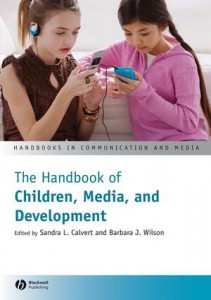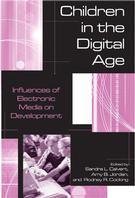Handbook of Children, Media, and Development.
Boston, MA: Wiley-Blackwell.
Calvert, S.L. & Wilson, B.J. (Eds.) (2008).Boston, MA: Wiley-Blackwell.
Every day children spend a significant amount of their waking time watching and interacting with the media. Once a mass experience that was generally one-way and observational, media have increasingly become more interactive. Cell phones, DVDs, plasma monitors, and wireless interfaces add increased control, clarity, and access to media wherever children may be.
Media use starts early, in the first year of life. Initial experiences are controlled by parents and caregivers, but increasingly give way to children’s preferences as favorite programs and preferred modes of interaction emerge. The degree to which these experiences are a positive as well as a negative source of developmental change in cognitive, social, and health areas is an ongoing intellectual debate with significant implications for today’s society.
The Handbook of Children, Media, and Development brings together an interdisciplinary group of experts in the fields of developmental psychology, developmental science, communication, and medicine to provide an authoritative, comprehensive, and up-to-date look at the empirical research on media and media policies within the field.
For more information about the book, click here.
Food Marketing to Children and Youth: Threat or Opportunity?
J.M McGinnis, J. A. Gootman and V. I. Kraak (Eds) and the Institute of Medicine Committee on Food Marketing and the Diets of Children and Youth. (2006). Washington, D.C.: National Academies Press.
Creating an environment in which children in the United States grow up healthy should be a high priority for the nation. Yet the prevailing pattern of food and beverage marketing to children in America represents, at best, a missed opportunity, and at worst, a direct threat to the health prospects of the next generation. Children s dietary and related health patterns are shaped by the interplay of many factors: their biological affinities, their culture and values, their economic status, their physical and social environments, and their commercial media environments. This book focuses on the impact of food and beverage marketing on the dietary patterns and health status of American children. This knowledge has the potential to shape the health status of our nation’s children and is the focus of Food Marketing to Children and Youth. This book will be of interest to parents, federal and state government agencies, educators and schools, health care professionals, industry companies, industry trade groups, media, and those involved in community and consumer advocacy.
For more information about the book, click here.
Children’s Journeys Through the Information Age.
Calvert, S.L. (1999). Boston: McGraw Hill.
Children’s Journeys Through the Information Age by Sandra Calvert addresses many of the issues surrounding our culture’s continuing immersion into technology, looking particularly at the current and emerging information technologies influencing children. Calvert poses questions about the effects of these technologies and discusses their meaning for parents, teachers, and policymakers. For instance, Calvert looks at specific software designs and mediums (i.e. TV, Diskette, CD-ROM) to explore how gender role, ethnic, and racial stereotypes are carried to intended audiences through implicit messages in these programs.
Dr. Calvert’s book is part of The McGraw-Hill Series in Developmental Psychology.
To order the book from Amazon.com, click here.
Children in the Digital Age: Electronic Media and Children’s Development.
Calvert, S.L., Jordan, A.B. & Cocking, R.R. (2002).Westport, CT: Praeger.
Television will be interactive, computers will provide feature-length motion pictures and TV programs, and information will be delivered like never before. Access to digital technologies is rapidly changing how children experience media, and how technologies will impact children’s development, and is making media an increasingly active gateway for experiencing and learning about the world. This volume considers how children use media today and how new media is emerging and merging with existing technologies. The distinctive features of both older and newer media are examined along with why these technologies are attractive to children and adolescents.
An interdisciplinary group of scholars from the fields of psychology, communication, sociology, and linguistics examine the effect of media experiences on children’s social, cognitive, familial, and consumerist experiences. Social policy implications of media effects are also considered.
For more information about the book, click here.
To order the book from Amazon.com, click here.



